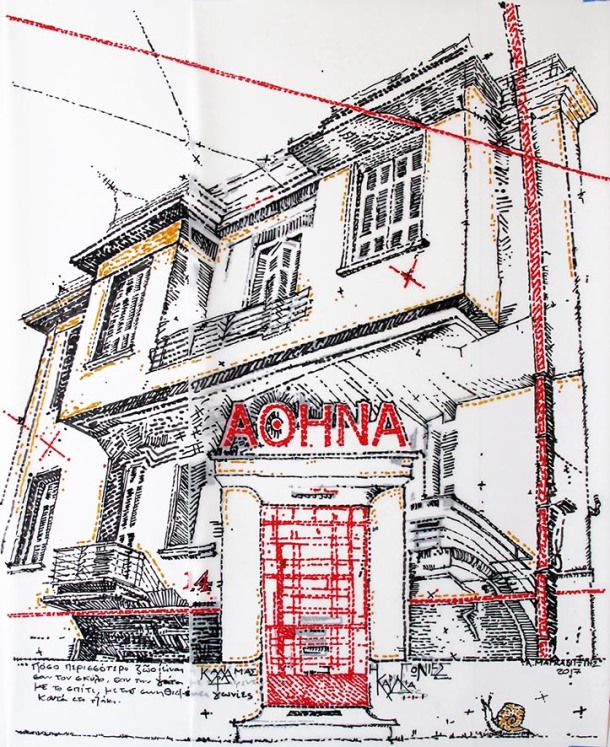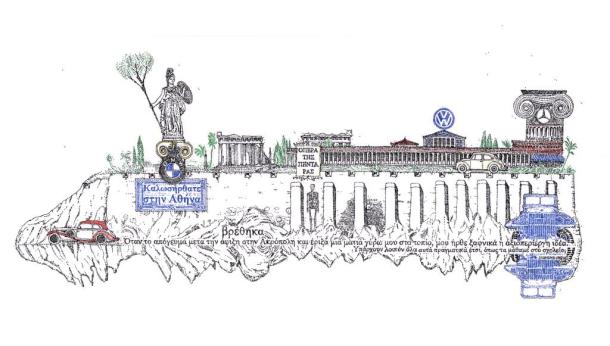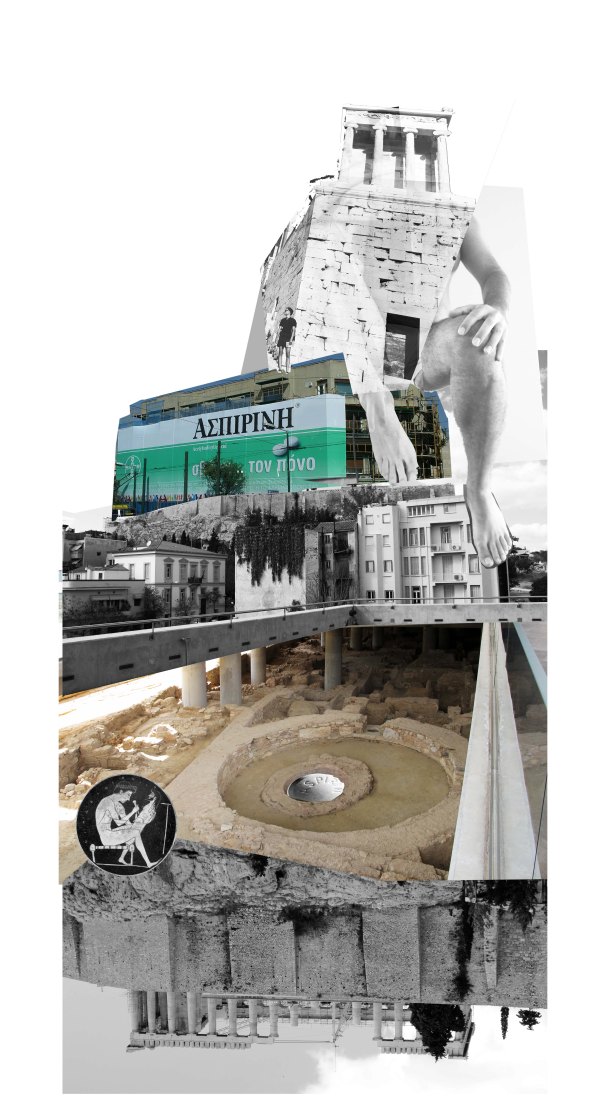Alexandros Maganiotis is an artist trapped into the body of an architect. Living in Athens, he is been inspired by the city from the realization of some works, like Postcards for Athens and A Disturbance of Memory, but mostly Athens influenced the technique that he uses in in works. Athens, as a juxtaposition of fragments from various era, is seen as a work of collage, where memory travels through time and the eye is constantly stimulated by its very details. In his work the collage is the mean to interpret Athens and it constitutes the background layer for a hand-drawing that reshapes and revitalizes what may seem lost, confused, haphazard. Alexandros Maganiotis thus has found a way to read the specific circumstances of the field of Athens, the ordinary and the forgotten, the exceptional and the strange, the accident and the improvisation, and actually redrawing a new organization system that rearranges the elements of the urban landscape in new material assemblages. The collage and the drawing are two level of interpretation and reassembling of the city of Athens, two moments of reflection put in sequence and thus integrated.
POSTCARDS FROM ATHENS

A. Maganiotis, Postcards from Athens
THE INTERVIEWER
You are an architect. Can you explain how have you turned into arts?
ALEXANDROS MAGANIOTIS
It seems that I was always an artist trapped in the body of an architect… but whatever I do it feels that I can’t escape the architect! I will always think as an architect, so my work always has a very solid structure.
THE INTERVIEWER
A series of your work, Postcards from Athens, is specifically based in Athens. To whom would you like to send these cards?
ALEXANDROS MAGANIOTIS
In 2015 I was invited to take part in an exhibition in Vienna that was when I had the idea of the postcards from Athens. So these works were exhibited there for the first time and they really made a strong impression to everyone that had an experience of visiting Athens.
THE INTERVIEWER
These postcards are a collage of diverse objects, buildings, mythological figures. They portrait Athens through multiple fragments. What’s the link between history, neoclassicism, and contemporary culture?
ALEXANDROS MAGANIOTIS
We are the “link”, the people that live in this city, we interact with it everyday and all these actions create a palimpsest. Whether we are professionals working here, tourists visiting, homeless seeking for a place to spend the night or youngsters tagging the walls with graffiti, we create the image of the city every day.
These last five years I have been living in the historic center of Athens, here the neoclassical past is very present. My studio is situated in Monastiraki one of the borders of the triangle that is defined by the two other squares of Syntagma and Omonia, an urban development that was designed in 1834 in order to give Athens the feeling of a state capital. A lot of the buildings are from that period and they give the area a unique character, but is the mix of all the contradictory elements that really makes the city exciting for me, along with all the myths that I feel are somehow still present in Athens. After all, the myth says the city was founded and got its name from Goddess Athena, this place is built on myth.
THE INTERVIEWER
These post-cards have a sort of pop attitude, through the use of large writings and bright colours, composition of elements out of scale. What kind of aspect of Athens are you intended to reveal?
ALEXANDROS MAGANIOTIS
I seek to reveal the ephemeral character of the city, which like an ever-changing text is being constantly re-written. My approach is, as you say, pop and always with a sense of humor since I don’t like to appear very serious-looking.
So in the process of working these Post-cards, I edited photographs I took of buildings from Athens with texts that I also collected from the city: shop-signs, posters or graffiti anything can be used to create a new image.
Back in the studio while I “photoshop” all this material I may also use images found on the internet, so a figure can escape from an ancient Greek vase and wander around the city, it is how I believe that we conceive the city, it’s not only the here-and-now but also the past and all the things we read or hear about Athens that create for us the full image of the city. It is a constant process in our minds that goes on while we try to explore the city.
A DISTURBANCE OF MEMORY ON THE ACROPOLIS

A. Maganiotis, A Disturbance of Memory
THE INTERVIEWER
Another set of drawings have the Acropolis Hill as main subject. A side elevation of the hill is mixed with various symbols and texts from different languages. How did you construct this portrait?
ALEXANDROS MAGANIOTIS
The idea behind the work came as a result of my traveling between Athens, Vienna and Berlin from 2011-2013 with a potential immigration on the back of my mind. I wanted to explore the Greek-German relations through time, and the first and strongest image that came to my mind was the proposal by the Bavarian architect K.F. Schinkel (1834) to build a new royal palace for Otto, the King of Greece, on the Acropolis in Athens. Contemporary Greeks on the other hand were obsessed with German cars, like BMW and Mercedes as symbols of wealth and status.
THE INTERVIEWER
The representation of the Acropolis Hill in elevation is very analytic, an orthographic representation showing its real dimension in elevation, very different from the perspective views of “Postcards from Athens”. How did you decide for this kind of representation?
ALEXANDROS MAGANIOTIS
The representation of Acropolis, was based, as I said before, on the architectural proposal of K. F. Schinkel and the elevation plan he did for the palace. So the representation is “official”, idealized, nothing like the everyday life of the street level that is portrayed on the postcards. The Acropolis is considered the cradle of civilization, it has a very distinct symbolic power, and Germans were obviously trying to set the link between the newly formed contemporary Greek State and the glorious past of Athens in the 5th century BC. Every trace of history in between, from the byzantine to the Ottoman times was erased in the drawing of Schinkel. In a way the Acropolis Hill was cut-off from the surrounding city, I emphasize more on that feeling by extracting the rock from the ground and leaving it floating, suspended on the air. It is a line of text that works like a razor and cuts the rock from the ground:“…So all this really does exist, just as we learned at school!” this phrase was written by S. Freud on his text called “A Disturbance of Memory on the Acropolis” (1936) after his visit to the Acropolis. He verbally describes the moment of realization that memory is selective and constructed according to a possibly illusionary perception of reality.
THE INTERVIEWER
Is the Acropolis still a valid symbol for Athens today?
ALEXANDROS MAGANIOTIS
The Acropolis is the most powerful symbol for Athens. Athens cannot exist without the Acropolis.
A COLLAGE OF FRAGMENTS

A. Maganiotis, Aspirin Collage
THE INTERVIEWER
How do you create you work?
ALEXANDROS MAGANIOTIS
The process consists of three stages, first I have an idea or a feeling about what I want to say and I start collecting material: photos I have taken, texts, found images. The next step is to digitally assemble them into one composition; this is now my base for a hand-drown painting. At this stage I make all the final decisions, what do I keep? what do I throw away, and what do I highlight? So the end result is hand-made, it enhances the memory of the digital collage and it merges all the heterogeneous elements in the unity of a drawing.
THE INTERVIEWER
Is there some particular reason why you use the technique of the collage? Is there any relation between this particular technique and how you would like to portrait Athens?
ALEXANDROS MAGANIOTIS
There is a very strong link between collage and the way we perceive Athens. I believe that there is no continuity in the city anymore, the layers of the city are overlaid and create a fragmented collage-like image, this is very present in cities like Athens or Rome. But its not only history creating this mix, especially in Athens everyone can leave his trace in the city, there is a feeling of freedom that can be good or bad on the same time, people can start initiatives and reclaim land for a park but also they can put posters or graffiti almost everywhere. I was deeply shocked by way buildings were burnt down or marble elements were destroyed in the riots of the last decade, but maybe it is the Architect speaking now …